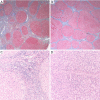Evolution of the liver biopsy and its future
- PMID: 33824924
- PMCID: PMC7829074
- DOI: 10.21037/tgh.2020.04.01
Evolution of the liver biopsy and its future
Abstract
Liver biopsies are commonly used to evaluate a wide variety of medical disorders, including neoplasms and post-transplant complications. However, its use is being impacted by improved clinical diagnosis of disorders, and non-invasive methods for evaluating liver tissue and as a result the indications of a liver biopsy have undergone major changes in the last decade. The evolution of highly effective treatments for some of the common indications for liver biopsy in the last decade (e.g., viral hepatitis B and C) has led to a decline in the number of liver biopsies in recent years. At the same time, the emergence of better technologies for histologic evaluation, tissue content analysis and genomics are among the many new and exciting developments in the field that hold great promise for the future and are going to shape the indications for a liver biopsy in the future. Recent advances in slide scanners now allow creation of "digital/virtual" slides that have image of the entire tissue section present in a slide [whole slide imaging (WSI)]. WSI can now be done very rapidly and at very high resolution, allowing its use in routine clinical practice. In addition, a variety of technologies have been developed in recent years that use different light sources and/or microscopes allowing visualization of tissues in a completely different way. One such technique that is applicable to liver specimens combines multiphoton microscopy (MPM) with advanced clearing and fluorescent stains known as Clearing Histology with MultiPhoton Microscopy (CHiMP). Although it has not yet been extensively validated, the technique has the potential to decrease inefficiency, reduce artifacts, and increase data while being readily integrable into clinical workflows. Another technology that can provide rapid and in-depth characterization of thousands of molecules in a tissue sample, including liver tissues, is matrix assisted laser desorption/ionization (MALDI) mass spectrometry. MALDI has already been applied in a clinical research setting with promising diagnostic and prognostic capabilities, as well as being able to elucidate mechanisms of liver diseases that may be targeted for the development of new therapies. The logical next step in huge data sets obtained from such advanced analysis of liver tissues is the application of machine learning (ML) algorithms and application of artificial intelligence (AI), for automated generation of diagnoses and prognoses. This review discusses the evolving role of liver biopsies in clinical practice over the decades, and describes newer technologies that are likely to have a significant impact on how they will be used in the future.
Keywords: Clearing Histology with MultiPhoton Microscopy (CHiMP); Liver biopsy; matrix assisted laser desorption imaging (MALDI); whole slide imaging (WSI).
2021 Translational Gastroenterology and Hepatology. All rights reserved.
Conflict of interest statement
Conflicts of Interest: All authors have completed the ICMJE uniform disclosure form (available at http://dx.doi.org/10.21037/tgh.2020.04.01). The series “Recent Advances in Rare Liver Diseases” was commissioned by the editorial office without any funding or sponsorship. Dr. VV reports grants from NIAAA/NIH (AA017754 and AA022057), during the conduct of the study; Dr. RT reports grant support from National Institutes of Health (NCI, R44 CA189522-01), during the conduct of the study; In addition, Dr. RT has an ownership interest in Applikate Technologies, a startup that is commercializing multiphoton histology, and related intellectual property. The other authors have no conflicts of interest to declare.
Figures





Similar articles
-
Utility of whole slide imaging and virtual microscopy in prostate pathology.APMIS. 2012 Apr;120(4):298-304. doi: 10.1111/j.1600-0463.2011.02872.x. APMIS. 2012. PMID: 22429212 Review.
-
Whole Slide Imaging and Its Applications to Histopathological Studies of Liver Disorders.Front Med (Lausanne). 2020 Jan 8;6:310. doi: 10.3389/fmed.2019.00310. eCollection 2019. Front Med (Lausanne). 2020. PMID: 31970160 Free PMC article. Review.
-
Whole Slide Imaging (WSI) in Pathology: Current Perspectives and Future Directions.J Digit Imaging. 2020 Aug;33(4):1034-1040. doi: 10.1007/s10278-020-00351-z. J Digit Imaging. 2020. PMID: 32468487 Free PMC article. Review.
-
The future of Cochrane Neonatal.Early Hum Dev. 2020 Nov;150:105191. doi: 10.1016/j.earlhumdev.2020.105191. Epub 2020 Sep 12. Early Hum Dev. 2020. PMID: 33036834
-
Validation of Whole-Slide Imaging for Histolopathogical Diagnosis: Current State.Pathobiology. 2016;83(2-3):89-98. doi: 10.1159/000442823. Epub 2016 Apr 26. Pathobiology. 2016. PMID: 27099935 Review.
Cited by
-
Deep-Learning-Based Hepatic Ploidy Quantification Using H&E Histopathology Images.Genes (Basel). 2023 Apr 16;14(4):921. doi: 10.3390/genes14040921. Genes (Basel). 2023. PMID: 37107679 Free PMC article.
-
Circulating angiopoietin-like protein 8 (ANGPTL8) and steatotic liver disease related to metabolic dysfunction: an updated systematic review and meta-analysis.Front Endocrinol (Lausanne). 2025 Apr 10;16:1574842. doi: 10.3389/fendo.2025.1574842. eCollection 2025. Front Endocrinol (Lausanne). 2025. PMID: 40276549 Free PMC article.
-
Portal Fibrosis and the Ductular Reaction: Pathophysiological Role in the Progression of Liver Disease and Translational Opportunities.Gastroenterology. 2025 Apr;168(4):675-690. doi: 10.1053/j.gastro.2024.07.044. Epub 2024 Sep 7. Gastroenterology. 2025. PMID: 39251168 Review.
-
Digital pathology systems enabling quality patient care.Genes Chromosomes Cancer. 2023 Nov;62(11):685-697. doi: 10.1002/gcc.23192. Epub 2023 Jul 17. Genes Chromosomes Cancer. 2023. PMID: 37458325 Free PMC article. Review.
-
Multimodal NASH prognosis using 3D imaging flow cytometry and artificial intelligence to characterize liver cells.Sci Rep. 2022 Jul 1;12(1):11180. doi: 10.1038/s41598-022-15364-7. Sci Rep. 2022. PMID: 35778474 Free PMC article.
References
Publication types
Grants and funding
LinkOut - more resources
Full Text Sources
Other Literature Sources
